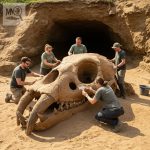Amazon’s Long-Necked Giant: A Prehistoric Titan Unearthed in the Rainforest
The Amazon rainforest is often called the “lungs of the Earth,” a lush and vibrant ecosystem that continues to reveal hidden treasures. Recently, paleontologists uncovered one of its most remarkable secrets yet: the fossil remains of a massive sauropod dinosaur, a long-necked giant that roamed the region more than 100 million years ago. Belonging to the titanosaur family—the largest land animals ever to walk the Earth—this discovery has reshaped the way scientists view the prehistoric Amazon and its ancient ecosystems.

A Glimpse Into Prehistoric Amazonia
For centuries, the Amazon Basin has fascinated explorers and scientists alike, but few imagined that beneath its dense vegetation lay the bones of creatures that once dwarfed the towering trees. The unearthed sauropod fossils, including enormous vertebrae and bone fragments, provide direct evidence that the rainforest was once home to colossal herbivores. These giants likely stood several meters tall, stretching their long necks to feed on the vegetation that flourished in swamps and floodplains.
The fossils tell a story of resilience and adaptation. Living in an environment far different from today’s jungle, these titanosaurs thrived in wetlands, shaping the ecological balance of their time. Their presence proves that the Amazon, now dominated by dense tropical canopies, once supported ecosystems capable of sustaining the largest creatures in Earth’s history.

Why the Discovery Matters
The unearthing of this Amazonian giant is more than just a scientific milestone—it is a window into a lost world. Until now, many paleontologists assumed that tropical environments were unsuitable for preserving or even sustaining such massive dinosaurs. This find challenges those assumptions, proving that the prehistoric Amazon was both a cradle of biodiversity and a sanctuary for the planet’s largest animals.
Furthermore, titanosaurs are crucial to understanding dinosaur evolution. As members of the sauropod lineage, they not only represent size and strength but also showcase adaptability. Their widespread fossils have been found across continents, but the Amazon discovery fills a critical gap in South America’s fossil record, offering fresh insights into migration patterns, diet, and climate conditions during the Cretaceous period.

Reconstructing a Lost World
Each bone fragment uncovered in the Amazon paints a vivid picture of a landscape long gone. Scientists imagine vast floodplains, rivers carving their paths through wetlands, and giant sauropods moving in herds, feeding, and shaping their environment. This reconstruction allows us to see the Amazon not only as a modern biodiversity hotspot but also as a prehistoric stage where Earth’s true giants thrived.
Conclusion
The discovery of a long-necked titanosaur in the Amazon is a groundbreaking reminder of how much we still have to learn about Earth’s history. It bridges past and present, showing that the Amazon Basin has always been a place of wonder and life on a massive scale. As paleontologists continue to uncover fossils and reconstruct this ancient world, the story of the Amazon’s long-necked giant will inspire both scientific inquiry and human imagination.











